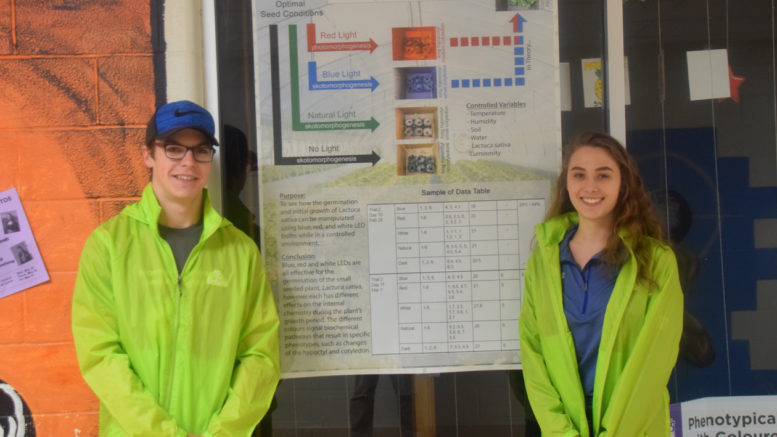Adam Prudhomme
Editor
When it comes to growing plants, not all light is created equal.
That was the discovery made by Napanee District Secondary School students Beth Reid and Hunter Bannon, who presented their findings at the Canada-Wide Science Fair, held in Fredericton, NB last month.
“We settled on the idea of manipulating how plants grow using different colours of light,” Bannon said of their project, which he says they have been tinkering with since November. “Specifically we used LED lights.”
“We focused on the stem growth and leaf growth of lettuce to see how it could elongate or shorten different characteristics to make lettuce more desirable for commercial use,” said Reid.
Using NDSS’ greenhouse as their lab, they put their hypothesis to the test.
“We built our own boxes so we could contain the light and have it for each specific type of light,” said Bannon. “We did white, blue, red LEDs, compared to natural and no light at all. Then everyday we went to the greenhouse. We watered them, checked on them, took measurements and took pictures for the entire month of February and into March.”
The results showed the plants had a definite preference.
“For the lettuce we saw the white light grew the lettuce the best since it contained the three wavelengths of red, blue and green,” said Reid. “Since the lettuce was green, the green got reflected. The ratio within the LED bulb was more high red than blue photons. A high red to low blue ratio of light could also simulate the same results as the white LED, but since we just used the pure light samples, the white light worked the best.”
They presented their findings at a regional science fair where they were selected to represent the Limestone District School Board during the week long Canada-Wide Science Fair at the University of New Brunswick.
The practical applications of their findings could help farmers in remote areas such as Canada’s north extend their growing season when daylight can be scarce. It could also be a boon to Canadian farmers coast-to-coast, improving their indoor growing operation.
“You can extend the growth periods for plants,” said Reid. “Aside from just one harvest season in outdoor farms, you can grow indoors and have the most desirable traits from a specific type of crop. We just used lettuce but you apply particular ratios to even tomatoes, cucumbers, a lot of vegetable type plants and grow them indoors. Vertical farming is very common right now in urban areas and they provide local produce or you can even have large greenhouse facilities in rural facilities.”
Both students credited several classmates and teachers for helping to prepare them for the national competition.
“Our Math teacher helped us make the statistics to graph the analysis of our information,” said Bannon. “Mr. Stewart helped us through the scientific process. We had basically the entire science department just come in and listen to our presentation and ask us questions and grill us. Our Drama teacher helped us learn to present and make eye contact. It was kind of a team effort. We had the Yearbook students help us make our poster.”
At the very core of the project, Reid says they both brought a unique skill set to the group that complimented each other’s strengths.
“We made a good team because we both clearly like science, but I was a little more into the biology and environment, he was really good at the physics part with the light and construction of the apparatus,” she said.
Though they didn’t place at the national event, both agreed they learned a lot just by talking with the judges and other like-minded science students.
Both in Grade 12, they will be heading to university next fall for Engineering. They both hope to continue to work on ways to create a more sustainable environment.

